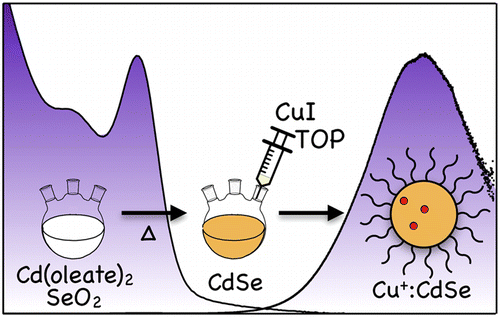当前位置:
X-MOL 学术
›
Chem. Mater.
›
论文详情
Our official English website, www.x-mol.net, welcomes your
feedback! (Note: you will need to create a separate account there.)
One-Pot Synthesis of Monodisperse Colloidal Copper-Doped CdSe Nanocrystals Mediated by Ligand–Copper Interactions
Chemistry of Materials ( IF 7.2 ) Pub Date : 2016-10-12 00:00:00 , DOI: 10.1021/acs.chemmater.6b02869
Luming Yang 1 , Kathryn E. Knowles 1 , Atchuthan Gopalan 1 , Kira E. Hughes 1 , Michael C. James 1 , Daniel R. Gamelin 1
Chemistry of Materials ( IF 7.2 ) Pub Date : 2016-10-12 00:00:00 , DOI: 10.1021/acs.chemmater.6b02869
Luming Yang 1 , Kathryn E. Knowles 1 , Atchuthan Gopalan 1 , Kira E. Hughes 1 , Michael C. James 1 , Daniel R. Gamelin 1
Affiliation

|
We report a one-pot synthesis of high-quality colloidal copper-doped cadmium selenide nanocrystals (Cu+:CdSe NCs) by injection of a mixture of copper iodide (CuI) and trioctylphosphine (TOP) into solutions containing preformed CdSe NCs. This method allows NC doping to be separated from nucleation and growth, thereby simultaneously achieving large size tunability, narrow size dispersion, and exclusively copper-based photoluminescence (PL). The copper doping level is affected by both the reaction time and the relative concentrations of the cadmium precursor, CuI, and TOP. A correlation is demonstrated between the copper dopant concentration and the intensities of the characteristic near-IR PL and midgap absorption bands, both associated with metal-to-ligand (conduction band) charge-transfer (MLCBCT) excitation of Cu+ dopants. Mechanistic studies reveal that Cu2–xSe NCs are easily formed as kinetic intermediates under reaction conditions involving substantial copper and that these NCs then act as a copper source for the subsequent formation of Cu+:CdSe NCs in the same reaction mixture. We also observe postsynthetic loss of copper from the doped NCs during shell growth or exposure to phosphines and amines, reflecting the high mobility of Cu+ ions in colloidal NCs.
中文翻译:

配体-铜相互作用介导的一锅法合成单分散胶体掺杂铜的CdSe纳米晶体。
我们报告了通过将碘化铜(CuI)和三辛基膦(TOP)的混合物注入包含预制CdSe NCs的溶液中,一锅合成高质量的胶体掺杂铜的硒化镉镉纳米晶体(Cu +:CdSe NCs)。这种方法可以使NC掺杂与成核和生长分离,从而同时实现大尺寸可调性,窄尺寸色散以及仅基于铜的光致发光(PL)。铜的掺杂水平受反应时间和镉前体,CuI和TOP的相对浓度的影响。证明了铜掺杂剂浓度与特征近红外PL和中带隙吸收带的强度之间的相关性,两者均与金属到配体(导带)的电荷转移(ML CB)相关CT)激发Cu +掺杂剂。机理研究表明,在涉及大量铜的反应条件下,Cu 2– x Se NCs易于作为动力学中间体形成,然后这些NCs充当铜源,随后在同一反应混合物中形成Cu +:CdSe NCs。我们还观察到在壳生长或暴露于膦和胺的过程中,掺杂的NC中铜的合成后损失,这反映了胶态NC中Cu +离子的高迁移率。
更新日期:2016-10-12
中文翻译:

配体-铜相互作用介导的一锅法合成单分散胶体掺杂铜的CdSe纳米晶体。
我们报告了通过将碘化铜(CuI)和三辛基膦(TOP)的混合物注入包含预制CdSe NCs的溶液中,一锅合成高质量的胶体掺杂铜的硒化镉镉纳米晶体(Cu +:CdSe NCs)。这种方法可以使NC掺杂与成核和生长分离,从而同时实现大尺寸可调性,窄尺寸色散以及仅基于铜的光致发光(PL)。铜的掺杂水平受反应时间和镉前体,CuI和TOP的相对浓度的影响。证明了铜掺杂剂浓度与特征近红外PL和中带隙吸收带的强度之间的相关性,两者均与金属到配体(导带)的电荷转移(ML CB)相关CT)激发Cu +掺杂剂。机理研究表明,在涉及大量铜的反应条件下,Cu 2– x Se NCs易于作为动力学中间体形成,然后这些NCs充当铜源,随后在同一反应混合物中形成Cu +:CdSe NCs。我们还观察到在壳生长或暴露于膦和胺的过程中,掺杂的NC中铜的合成后损失,这反映了胶态NC中Cu +离子的高迁移率。

































 京公网安备 11010802027423号
京公网安备 11010802027423号